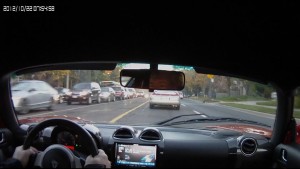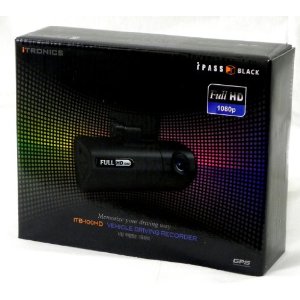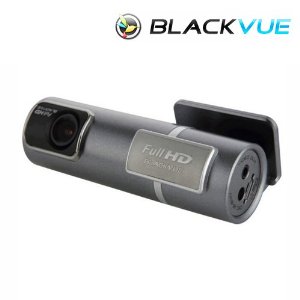Dash-Cams, Crash-Cams and Cop-Cams – and why you should, too
Even peeking in at YouTube these days can be risky business, but if you’ve ventured there at any time during 2012, you’ve probably seen the myriad dash-cam videos – most of them from Russia. The Russians have been installing cameras in their cars like never before, mainly because the fall of the Soviet Union apparently did nothing for the quality of their roads, and because people in general are concerned withe themselves before anyone else. Strange, huh?
A recording from a dash-cam is likely all the evidence between the driver and the opportunist who backed into them, aiming to claim that they were rear-ended, or the cop looking for a little extra cash for taking the time out of his day to pull them over, or whatnot else might (and frequently do) occur on Russian roads. But that’s Russia, right? Not really ‘Red’ Russia anymore, but still… why should you have one? Don’t worry – we’ll tell you why, and we’ll even tell you how and which.
What’s a Dash-Cam?
A dash-cam is a camera mounted inside your car, in order to record events either inside your car our outside it. Some will record audio as well, though that can be a bit of a hassle, due to wiretapping laws (and misinterpreted wiretapping laws…) in some locations. Mostly, though, audio recording is extremely encouraged. If you’re gonna have a camera in there, you’ll want the audio too, trust us.

But what about the crash-cam and cop-cam? They’re the same thing, just other words for that same thing. Neat, huh? It all depends on what you think your biggest risk is – cops or crashes, we suppose. Or theft… but that didn’t sound as cool, so we left that out.
Just like any other electronic gadget, there are hundreds of models and variations out there to choose from, and finding the one which is right for you can be a real PITA.
Choosing one for yourself?
There’s acouple of things you have to figure out before you get a dash-cam/crash-cam/cop-cam. We’re going to lay it out for you like we always do – nice, neat and easy. So here’s a bullet list for you.
- Decide if you want to record the interior or exterior of the car, or both.
- Decide if you want to record audio as well as video (recommended).
- Decide if you want to record all the time, just at an accident, or manually.
- Decide if you want HD recording or not (HD is recommended).
- Decide how long you want to be able to record (1GB equals ~1 hour of video w/audio).
You’ll also have to decide if this is something you’re comfortable installing yourself, or if you should budget in some professional help for that. Remember that there’s stuff you have to take apart on your car, there’s electrical work as well as the challenges of securing brackets and bolts and all that stuff. It’s not for everyone.
The Best and Brightest
Since we like gadgets, we know and love security, and we’ve got some DIY skillz happening, we’ve taken a look at the options we like the best, and we’re going to give you a look at a few of the options we think are most viable, both for the amateur and the professional. Feel free to ask us questions in the comments or by email if there’s anything you’re not sure about. We may be slow sometimes, but we do read all comments and answer all questions. Eventually.
Itronics ITB-100HD Car DVR

Hell, why not – just start with one that has everything, right? Right.
- H.264 Compression – 1 Lux IR Night Vision – Full HD: 1920 x 1080p / 1280 x 720p / 720 x 480p
- Built in GPS
- 8GB Class 10 SD Card Included (3-13 hours depending on resolution settings)
- Parking Mode with Shock and Motion Sensors – Record Incidents While Vehicle is Unattended
- -20 to 70C (158 F) Operating Environment – Does Not Suffer Heat Issues
Note; in parking mode, this thing will “see” movement as well as “feel” it – if something moves in the camer’s line of sight, it will start recording – not just if someone tries to break into your car or truck or whatever it is you drive.
The ITB isn’t the cheapest unit out there, but it’s likely one of the best. You don’t need to record video on the highest setting – the lowest one will still let you see faces, read license plates, signs, etc, and swithing the included 8GB card for a 16 or 32 GB card will up your recording time to ~30 hours, which adds up to quite a few days of driving for most people.
The ITB-100HD comes with about 10 feet of power cable, giving you a lot of freedom when it comes to placing the camera – recording the inside of the car from any angle works fine, since the cable will reach the dash and the power sources under it easily. Recording the back of the car is also no problem, since you can usually get power from the lights or splice into the supply for a power antenna, etc.
This thing will record audio and video in HD, which is good. What’s not so good is that it’s only one camera. Placing it like the topmost picture in this article will help that. The wide angle will help you include the driver’s side window if you install it correctly, something that is highly recommended, since that’s where you’ll be approached should you be pulled over or get in a wreck.
However… there’s one angle you can’t cover with only one camera, and that’s why we’re including this next one…
BlackVue DR-400G-HD II
Lots of letters and numbers there, but what it comes down to is this: the ideal backup camera for your car, making sure that you’ve got every angle covered.

The dash-cam unit is tiny – and that’s why we like it as a rear view camera for recording your journeys. It won’t impede your crucial view to the back, and it can record in full HD. So why not use it as the main, forward looking camera? Because of its size. It’s small enough to be looking forward, but because of its size, the audio recording is not up to par.
This thing will record G forces and GPS data as well, which makes it a great tool should someone rear end you, and you need proof for your insurance claim, court cases or police actions.
Should you be pulled over and removed from your car, this will keep everyone accountable, and is an excellent defense against false accusations, plants and harassment, both from citizens, law enforcement, border agents, TSA, criminals, bad drivers and whatnot else you’ll encounter on the road.
There’s a lot to be said for having a rear facing camera, and it will give you a definite advantage over a lot of drivers out there, no matter who they are.
Cop-Cam…?
The police have been using cameras for a long, long time, in order to protect themselves and to provide evidence for prosecution, document officer behavior and provide training for new officers. When it comes to security, this has done a lot for the police, and dash-cams have put a lot of both big and small offenders behind bars, or left them with a sizable hole in their wallets. But dash-cams are also hazardous.
Why? Because they’re out of your control. In some countries, recordings will not be given out to anyone under any circumstance, and in other countries, lengthy procedures (like FOIA requests, etc.) has to be set in motion before there’s even a chance of seeing yourself getting to wear handcuffs. More and more often, the dash-cam recordings have been “corrupted”, “lost” or been “non-existant” for various reasons, especially in cases where an officer has been to blame for misconduct or other errors. Having two cameras in your car, recording both forward and backwards, including audio, is not something the police would expect, and having double cameras will make it very hard for all the video to disappear.
We here at SnallaBolaget support the police. We support law enforcement and security personell, but we do realize, unlike some people, that recording and accountability is crucial to maintaining trust and cooperation and security for all those involved in incidents, big and small. That is also why we’ve been adamant about supporting laws that protect the right to photograph and film the police and security, so long as there’s no interference. We intend to stand by that, and support anyone who find themselves prosecuted or harrassed for documenting law enforcement and security in public.
